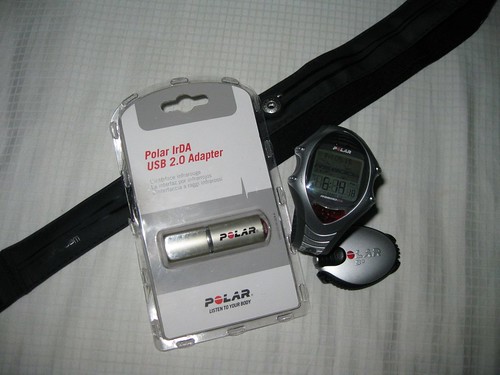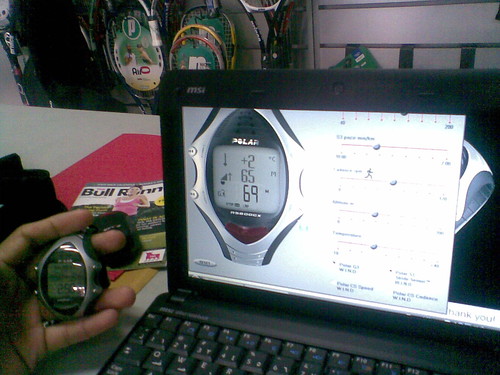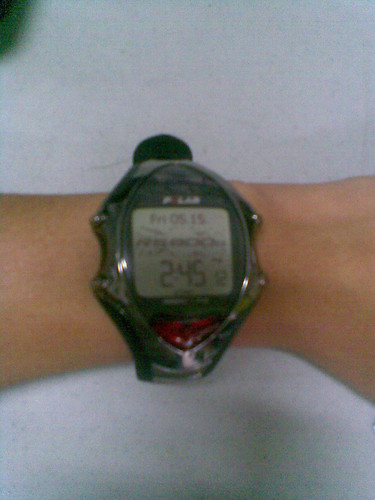My New House Guest: Polar RS800CX
For the next seven days, I will play courteous and hospitable host to a special guest in my home, the Polar RS800CX, the top of the line training watch of Polar for elite runners. I will take him around the city, touring my favorite routes on foot, on a bike or in the water, and perhaps he may even join me on a short excursion to Clark for the TNF 100. He’ll only be staying for a week as he is a demo unit lent to me by Polar.
Yesterday, I met Hitler Dulay of Sports Resources Inc., the local distributor of Polar Watches. Our meeting lasted for over three hours as he introduced to me the various models of Polar watches (with more emphasis on the running watches, of course.) He presented the Polar simulator on his laptop, which was a cool program that allowed one to click on the watch onscreen and view its features and performance during a pretend workout.
Polar has various running watches: RS100, RS300X, RS400, and RS800. But, it was the Polar RS800CX that got my attention; the features on this watch are simply astounding.
I jotted down all the key points that Hitler mentioned which made it seem like a better buy than the Garmin 310 XT, to be released in June, which targets multisport athletes as well. (Good thing I told hubby to hold off on buying my birthday gift until I can decide on the Garmin 310XT!) Please note that this is not a comprehensive list of the Polar RS800CX’s features—you may click here for that—but these are the points that make the Polar better than the Garmin in this bull’s eyes:
- May be used as a watch. One can wear the Polar all throughout the day as a watch. The Garmin Forerunner 305 may only be used during the activity as battery life is short and, being GPS-based, it does not work indoors. The 405 may be used as a watch but you have to charge it often.
- Longer lifetime. The Polar has a replaceable battery in it, like regular watches. The Garmin will eventually die in around 2 years; it’s as disposable as a cellphone unit.
- No charging. Since the Polar is powered by a battery, one doesn’t need to charge it like a Garmin.
- Cadence and stride. Both Garmin and Polar will provide info on time, distance, pace, speed, calories, and heart rate. But, the Polar can give info on cadence (no more counting my steps!) and stride.
- Running Index. This is a feature that will allow you to track your progress from previously recorded runs.
- Fitness Test. Once a month, with the click of the Fitness Test button on the Polar, your watch can test your fitness, compare it with previous records, and provide info on your current fitness level.
- Shoe recording. One can store three different shoe info on the watch. As long as you note which shoe you used for the run, the Polar will record what shoe you used for the activity. (No more writing this down on my journal!)
- 2 year warranty and local service center. Majority of local Garmin users purchased their units in the U.S. as I did mine. I worried over repair should the Garmin conk out. WIth the Polar, there’s a 2-year warranty (approximately the lifetime of the Garmin) and a service center in Pasig.
- Heart rate zone training. Both the Garmin and Polar allow for use of heart rate monitors. But, the Polar’s strength is in heart rate monitors while the Garmin in their GPS systems. For those who want to train efficiently using their heart rate, the Polar is a much better choice.
- GPS. I was pleasantly surprised to learn that the Polar has a GPS option. GPS was the only reason why I bought the Garmin 2 years ago!
- Lighter. The Polar RS800CX is sleeker, lighter, and less bulky than the Garmin Forerunner 305. I enjoyed the snug fit around my wrist.
- Water resistant. For runners who swim, like me, water resistancy is important. The Garmin Forerunner 305 and 405 cannot be used in the pool. I read that the Garmin 310XT, although water resistant, will only work like a timer during a swim. The Polar can swim. I guess that’s why in the local triathlon scene, more triathletes choose Polar over Garmin.
Right now, I see only two downsides to the Polar RS800CX:
- GPS as a separate unit. To use the GPS, one has to purchase the GPS3 separately, which costs around P10,000. To make it worse, it is quite bulky and it has to be strapped to the arm.
- Expensive. The Polar RS800CX costs P27,000, which excludes the GPS unit.
I have yet to play around with my new toy this week. Tomorrow, I’ll run with both the Garmin Forerunner 305 and the Polar RS800CX to check on the Polar’s accuracy. I’ll let you know how it fares. Maybe then I’ll decide if I should invite him to stay in our house permanently!








